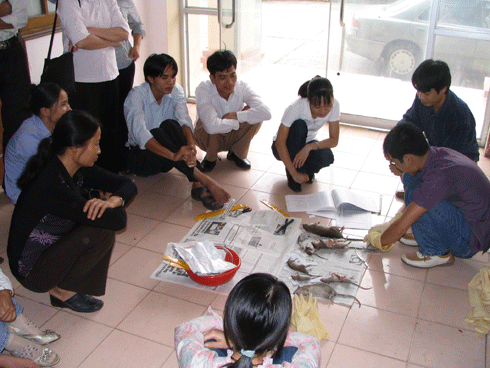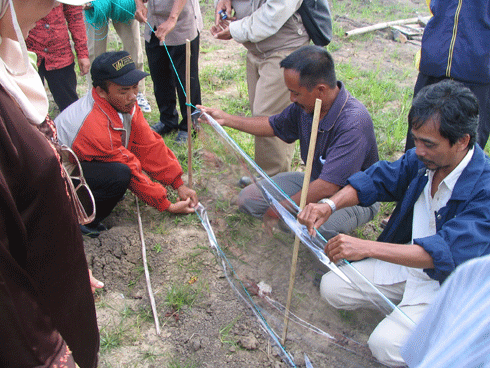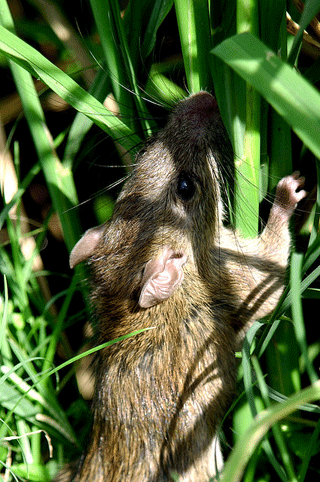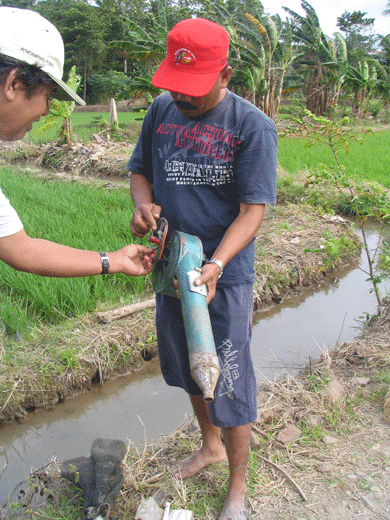
|
Published: 13 August 2012
Ecologists spring a trap for rice-loving rats
CSIRO scientists have long known of the link between rodent breeding and rice cropping, especially in countries where rice is a staple. Now, they have used this understanding to develop an ecologically based management approach for keeping rats at bay – an approach that eliminates the use of costly baits and poisons.
Rice farmers in South-East Asia will tell you, without hesitation, that rats are public enemy number one. Because are fast breeders, notoriously difficult to control, clever and highly adaptable (see our recent ECOS article), they destroy crops before farmers get a chance to harvest them.
In Asia alone, the rice lost to rodent pests could feed about 200 million people each year. Rats also carry serious human diseases, so their proximity to the human environment is a major health concern.
There has been no shortage of ideas in the war against rats in South-East Asia. Fumigation, electrocution, zapper traps, glue boards, baits and poisons have all been tried, but with little success. Fast-acting rat poisons, for example, are only effective in the short-term; when rats see their effect on fellow rodents, they will try to avoid these products. Rats are also more cautious than mice when approaching new objects or surroundings.
Natural rodent predators, such as snakes and birds of prey, have been released in or near some rice fields. Villagers also often keep cats to kill rats that threaten grain-storage areas. Predators are not without their problems, though: they can kill non-target animals, and also pose a further risk to human health and the environment.
In an attempt to starve the rats, some farmers have even avoided planting a crop, creating an extended fallow period. As the farmers discovered, however, hungry rats do not breed but simply migrate to more bountiful locations.1 The rats return the moment the fallow fields are replanted.
So what can rice farmers do?
Rodent ecologist Dr Peter Brown and his CSIRO colleagues have used their knowledge of rodent behaviour and reproduction to come up with a new way to keep rats at bay. They have implemented an ecologically based rodent management approach (EBRM), funded by the Australian Centre for International Agricultural Research (ACIAR).

|
|
Participants at a ‘train the trainer’ course in the Red River Delta area of Vietnam learn about the biology of rats. Credit:
Peter Brown/CSIRO
|
The approach has been tested in village-scale experiments involving lowland, irrigated rice crops.2 The beauty of the EBRM is that it does not rely on the use of expensive, toxic or environmentally damaging poisons.
'Farmers are telling us that they're losing 20–30 per cent of their rice yield: up to 100 per cent in some cases,’ says Dr Brown.
‘They are trying to do all these sorts of things independently of each other, yet they've still got a problem. This would just lead to the rapid reinvasion of treated crops by the rats from neighbouring fields.
'Farmers often wait to control the rat infestation after the damage has already occurred. We worked with farmers to try to manage the problem early to prevent damage to crops.
‘Based on our knowledge of the ecology and biology of the rice-field rat (Rattus argentiventer), our approach was to look at the management of their habitat and how we can time the controls so we do the management before they start breeding. We believe that if you kill one rat early in the rice crop, it will save having to kill 500 rats by the end of the crop cycle.
‘We knew that if we got the farmers to synchronise their cropping so that they all planted at the same time, the breeding season would be kept short; whereas if the farmers planted at different stages, the rats would disperse, colonise new crops as they ripen and continue breeding.’
In 2008, CSIRO scientists helped farmers to implement EBRM in Vietnam’s Ha Nam province in the Red River delta and An Giang province in the Mekong River, again through ACIAR funding. The team also supervised EBRM implementation in parts of Indonesia – Karawang district, West Java, and the Pinrang district in South Sulawesi.
The Indonesian villages that practised EBRM had a mean increase in rice yield of six per cent. In Vietnam, while crop production levels were largely unchanged, rat control costs were reduced. Both countries substantially reduced rodenticide use in villages practising EBRM.3

|
|
Community involvement is a vital to the success of the strategy: here farmers in South Sulawesi, Indonesia, learn how to set up a plastic barrier fence. Credit:
Peter Brown/CSIRO
|
A key EBRM practice is establishing baited community trap-barrier systems (CTBS) that lure rats into a small area planted before the main crop. The trap crop is surrounded by a barrier interspersed with trapping cages. As the lure crop ripens, rats find themselves steered into the cages of the barrier fence as they attempt to reach the crop.
Dr Brown explains that the community trap-barrier systems method works best when adopted by an entire farming community, where rat densities and crop losses in surrounding areas are high.
‘Benefit–cost analyses indicated that losses would have to be greater than 30 per cent for the CTBS method to be cost-effective on a regular basis,’ he adds.
The success of the most recent ACIAR project based in Indonesia and Vietnam was largely due to the cooperation between farm communities and the coordination of control activities. This was supported by training in preventative approaches before the rats surged in numbers. For farmers within these communities, the shared benefits of CTBS systems outweigh the shared costs, including labour and maintenance.
‘Since 2006, 17 000 farmers have been trained in Vietnam and 20 000 farmers trained in Indonesia to implement EBRM,’ says Dr Brown.
‘Initially, it was challenging to convince communities to work together when the rat population was fairly low. However, once we helped mobilise them into collective action, they enjoyed working together to share their knowledge and outsmart the rats.’4
Dr Brown adds that further research is required to implement these EBRM strategies across affected regions in Asia – including scaling them up to ensure effectiveness at a broader scale.5
1 Rat traps breeding cycles (2006)
2 Australian Centre for International Agricultural Research
3 Singleton GR, Brown PR, Jacob J (2004) Ecologically-based rodent management: its effectiveness in cropping systems in South-East Asia. NJAS – Wageningen Journal of Life Sciences, 52, 163–171.
4 Final Report: Implementation of rodent management in intensive irrigated rice production systems in Indonesia and Vietnam (2010)
5 Singleton GR, Belmain SR, Brown PR (2010) Rodent Outbreaks: Ecology and Impacts





